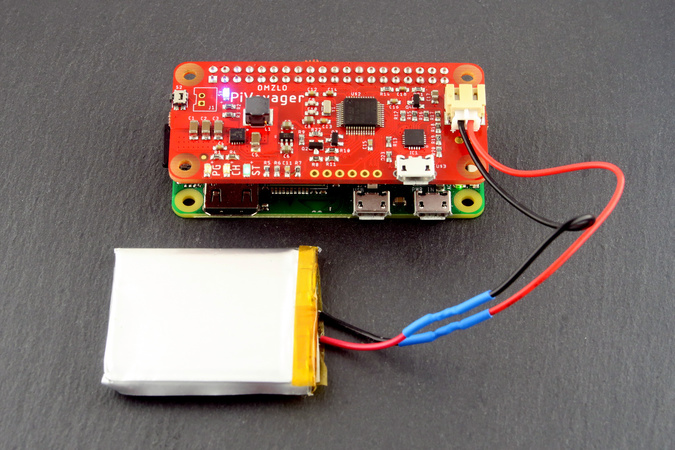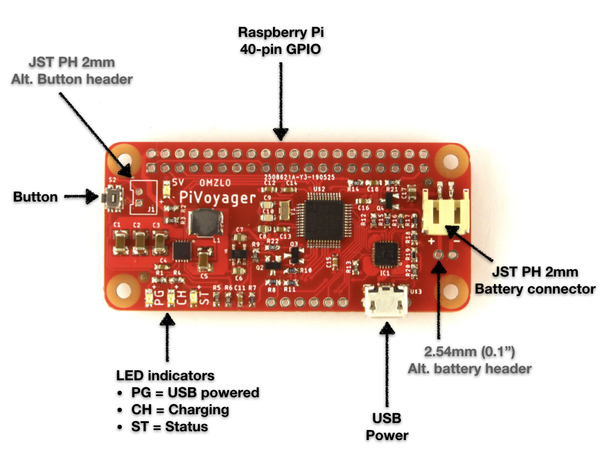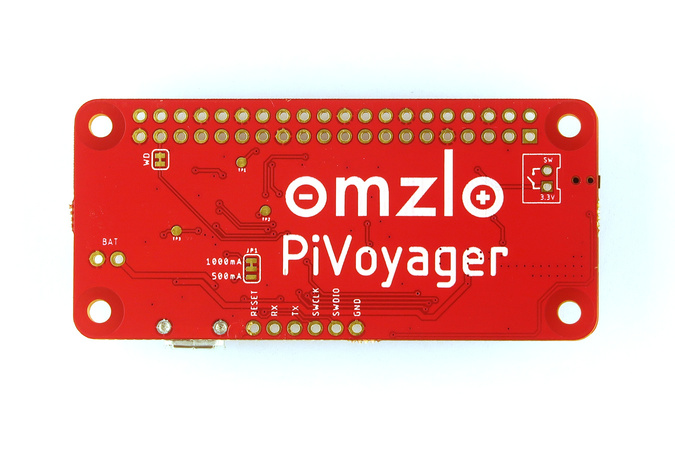
Run your Raspberry Pi on battery and take it anywhere!
The PiVoyager is UPS for the Raspberry Pi designed to work with standard Li-Ion or LiPo batteries, featuring a programmable watchdog, automatic restart, and a real-time calendar. The PiVoyager is designed as a Pi Zero pHAT, but works on any Raspberry-Pi with a 40 pin header, including the Raspberry Pi 3B+ and 4.
Featured in:

CNX Software - Embedded System News
If powering your Raspberry Pi based project has always being a concern to you, then you don’t have to worry about it again with the introduction of the PiVoyager.

Hackster.io
The board offers UPS status monitoring, giving users a wealth of data, including what kind of power is being supplied (USB or battery), current voltage, and current date/time (among a host of others).

Tindie - blog
The PiVoyager is the latest in UPS technology that works with standard Li-Ion or LiPo batteries.
Description

The PiVoyager is a UPS for the Raspberry Pi. If plugged to a USB power source (USB micro-B) and a Li-Ion/LiPo battery, it will both power your Raspberry Pi and charge the battery if needed, with a charge current of 1000mA. If USB power is removed, the PiMaster automatically switches to the battery and continues to power the Raspberry Pi at 5V, thanks to its boost converter.
The PiVoyager has a small button. Pressing this button for more than 3 seconds will shut down the Raspberry Pi. Once shut down, the Raspberry Pi can be restarted by pressing the same button. It is possible to add a JST PH header on the PiVoyager to connect your own tact switch as an alternative to the one provided on the pHAT.
The PiVoyager has four indicator LEDs, 3 at the bottom left and 1 at the top left:
- PG: green, indicates USB power
- CH: yellow, indicates charging status
- ST: red, indicates overall status
- 5V: blue, indicates that the Raspberry Pi is currently powered
The PiVoyager does not include battery protection circuity and should be connected to Li-Ion or LiPo batteries with their own protection circuit, using the two-pin JST PH header. You can find these batteries from your favorite vendor, including Adafruit, Pimoroni, or Sparkfun. If you can't find a battery with the JST PH header, an alternative 2.54mm 2-pin header is also provided for battery connection.
The PiVoyager is targetted at batteries with a nominal voltage of 3.7V, a charging voltage of 4.2V and supporting a charge current of 1000mA. The battery is considered as LOW if the voltage falls below 3.1V and will remain in LOW state until the voltage rises above 3.3V. At startup, the PiVoyager will refuse to power the Raspberry Pi when in LOW state and will wait for the battery to charge sufficiently first.
The PiVoyager features a Real-Time Calendar (RTC), which can be configured to store the current date and time. The content of the RTC will be maintained for as long as there is a power source connected, even if the Raspberry Pi is powered down.

The back of the PiVoyager
Smart UPS features
In addition to the basic UPS functionality, the PiVoyager hosts a microcontroller that communicates with the Raspberry Pi and provides the user with additional functionalities, inspired by our PiWatcher.
a) UPS status monitoring
The user can obtain the following information at any time:
- Whether a battery is present or not, and whether it is charging or not
- Whether the USB is providing power or whether the device is running on battery
- The current battery voltage
- Whether the user has pressed the button
- The current date and time stored in the RTC
b) Programmable I2C watchdog
Define a watchdog delay D in seconds. The PiVoyager will then start an internal timer that gets incremented every second. If the PiVoyager receives any I2C command, it resets the timer to 0. However, if the timer ever reaches D the PiVoyager will be fully shut down.
As such, this provides a good way to cleanly shut down a raspberry pi, by applying the following procedure:
- Set a watchdog to 20 seconds (e.g. using the command
pivoyager watchdog 20). - Issue a
sudo haltcommand.
This will assure that the Raspberry Pi is fully shut down in 20 seconds, consuming no current at all. The user can program the PiVoyager to restart the Raspberry-Pi after a specific event (see further down below).
c) Programmable GPIO watchdog
The watchdog works like the I2C one, except that a shutdown will be initiated if the GPIO26 pin of the Raspberry Pi is low for more than D seconds.
d) RTC: Real-time calendar
The PiVoyager offers a real-time calendar, providing time and date. The calendar remains active even when the Raspberry Pi is shut down, as long as there is battery power or USB power.
e) Programmable wake-up Alarm
The PiVoyager has a programmable alarm which can be used to wake up the Raspberry Pi at a specific date or time.
f) Programmable wake-up delay
The Pivoyager can be programmable to automatically wake up the Raspberry Pi after a certain delay, once it has shut down (e.g. after 10 seconds).
Note that this functionality cannot be used simultaneously with the alarm.
g) Restart options
After shutdown, the PiVoyager can be configured to restart after any of these events:
- A button press (default)
- Power reconnected on USB
- An alarm or wake-up delay
h) Automatic shutdown on low battery
By default, the PiVoyager will automatically shut down after 60 seconds if these two conditions are verified:
- it is battery powered and
- the battery voltage goes below 3.1V approx.
This feature can either be disabled or the delay can be changed.
i) I2C bootloader
The PiVoyager includes an I2C bootloader that enables you to upload new firmware to the device. Since everything is released as open-source, you can even write your own firmware if you wish!
Hardware
The PiVoyager is open source hardware.
The PiVoyager measure 65mm x 30mm and features:
- A Microchip MCP73871 LiPo/Li-Ion charger
- A Texas Instrument TPS61232 x high-efficiency boost converter providing up to 2.1A
- An ST STM32F030 Arm Cortex M0 microcontroller.
In standby mode, when the RaspberryPi is unpowered, the PiVoyager consumes approximately 30 μA.
The PiVoyager will be sold with a choice of a short lead 40-pin header or a stackable long lead 40-pin header.
The following Raspberry Pi GPIO pins are used by this board:
- I2C pins 2 and 3.
- Optionally, pin 26 for the GPIO watchdog.
The PiVoyager comes without a battery.
Resources
Buy a PiVoyager from our online store or from Tindie!
If you just bought a PiVoyager follow the link below to get started.
Go to installation and tutorial
Design files:
Tell us what you think of the PiVoyager on the forum or on Twitter.

Comments
We want to use the PiVoyager with node-red platform. Is there a list of I2c commands/registers available? As we want to talk to the board directly not through pivoyager app
Thanks Lawrence
Lawrence Griffiths, about 6 years agoHi Alain, we are happy about PiWatcher and we are sure PiVoyager is also a great shield but it come without CE mark: is it correct? Do you have project to mark it? Kind regards.
Massimo Nannizzi, about 6 years agoI'm using pi 3b+. I want to start from the charging state from a switch other than the attached switch, Can you start by inputting to the gpio terminal? please tell me.
Toshiyuki Tsuji, over 5 years agoHi,
I am wondering if this product can be configured to have the watchdog functionality to be used as a power cycle. The intent is for use in a remote application with ssh access. If the device is somehow ever shutoff while the power is still plugged in, it will not be able to be be restarted unless the power is cycled (or the P6 Run header is used) - although there will be no one physically there to do these actions.
I looked through the main.c program and the project documentation and its unclear to me if this functionality can be set up. It seems that the wakeup (power cycle) can be programmed to start when the 5V power is re-connected, but will this mode issue the wakeup power cycle when the raspberry pi has shutdown and the 5V power remains connected (never having been disconnected, thus never "re-connecting").
See this forum post https://forums.raspberrypi.com/viewtopic.php?t=150358 for more details on the functionality I am looking for. I'd rather buy the PiVoyager with the form factor already designed as opposed to having to prototype and fabricate it myself.
Thanks
Brad, almost 4 years agoHi,
I am wondering if this product can be configured to have the watchdog functionality to be used as a power cycle. The intent is for use in a remote application with ssh access. If the device is somehow ever shutoff while the power is still plugged in, it will not be able to be be restarted unless the power is cycled (or the P6 Run header is used) - although there will be no one physically there to do these actions.
I looked through the main.c program and the project documentation and its unclear to me if this functionality can be set up. It seems that the wakeup (power cycle) can be programmed to start when the 5V power is re-connected, but will this mode issue the wakeup power cycle when the raspberry pi has shutdown and the 5V power remains connected (never having been disconnected, thus never "re-connecting").
See this forum post https://forums.raspberrypi.com/viewtopic.php?t=150358 for more details on the functionality I am looking for. I'd rather buy the PiVoyager with the form factor already designed as opposed to having to prototype and fabricate it myself.
Thanks
Brad, almost 4 years agoHi,
I am wondering if this product can be configured to have the watchdog functionality to be used as a power cycle. The intent is for use in a remote application with ssh access. If the device is somehow ever shutoff while the power is still plugged in, it will not be able to be be restarted unless the power is cycled (or the P6 Run header is used) - although there will be no one physically there to do these actions.
I looked through the main.c program and the project documentation and its unclear to me if this functionality can be set up. It seems that the wakeup (power cycle) can be programmed to start when the 5V power is re-connected, but will this mode issue the wakeup power cycle when the raspberry pi has shutdown and the 5V power remains connected (never having been disconnected, thus never "re-connecting").
See the forum raspberry pi forum topic: t=150358 for more details on the functionality I am looking for. I'd rather buy the PiVoyager with the form factor already designed as opposed to having to prototype and fabricate it myself.
Thanks
Brad, almost 4 years agoGreat unit, can't find any information on disabling the flashing LED's.
Any advise on how to disabled them entirely?
Thanks!
Faychu, over 3 years agoЦены на создание сайтов вполне соответствуют качеству работ. Что, помимо хорошего дизайна, я подразумеваю под "качеством"? Все сайты обладают так называемой "кроссбраузерностью" - корректным отображением контента на любом компьютере. Сайты хорошо оптимизированы для поисковых систем, имеют аккуратный и интуитивно понятный интерфейс. Также осуществляется по-настоящему оперативная техническая поддержка. Обращаясь к частному специалисту, Вы минуете сложную систему взаимодействия с менеджерами, маркетологами и т. д, и общаетесь непосредственно с тем, кто делает Вам сайт.
Необходимо
установить Flash Player
для просмотра слайдов.
Стоимость создания "сайта-визитки":
Стоимость создания простого "сайта-визитки" (до 5 страниц, до 10 увеличиваемых изображений) составляет рублей. Стоимость крупного "сайта-визитки" (от 5 до 10 страниц, от 10 до 50 увеличиваемых изображений) - рублей. Дизайн страниц - корпоративный (как, например, на данном сайте). В сумму, кроме разработки дизайна и создания страниц, включены: доменное имя и хостинг сроком на один год, до десяти электронных почтовых ящиков, программа для редактирования сайта, счётчик посещаемости сайта. Вы получаете сайт "под-ключ". О порядке работы, сроках и условиях смотрите ниже, в соответствующих разделах страницы.
Стоимость создания интернет-магазина:
Изготовление интернет-магазина - рублей. В сумму, кроме разработки дизайна, включены: доменное имя и хостинг сроком на один год, до десяти электронных почтовых ящиков, счётчик посещаемости сайта, удобная и многофункциональная система управления магазином (административный раздел) и обучение пользованию системой управления. Наполнение интернет-магазина продукцией Вы производите самостоятельно через лёгкий и удобный административный интерфейс. Пример интернет-магазина: сайт "Baimao". C функциональными возможностями интернет-магазина Вы можете ознакомиться здесь. О порядке работы, сроках и условиях смотрите ниже, в соответствующих разделах страницы.
Стоимость создания сайта большого объёма или с необычным дизайном:
Стоимость создания сайта большого объёма (более 10 страниц и более 50 увеличиваемых изображений) или с необычным, сложным дизайном - от рублей. В сумму, кроме разработки дизайна и создания страниц, включены: доменное имя и хостинг сроком на один год, до десяти электронных почтовых ящиков, программа для редактирования сайта, счётчик посещаемости сайта. Вы получаете сайт "под-ключ". О порядке работы, сроках и условиях смотрите ниже, в соответствующих разделах страницы.
Чтобы начать работу, нам с Вами необходимо встретиться в Вашем офисе, дома или в кафе. Я работаю по предоплате, которая составляет примерную треть от стоимости сайта. При встрече желательно иметь рядом компьютер с возможностью выхода в сеть Интернет, чтобы можно было ознакомиться с сайтами-примерами, которые более всего соответствуют Вашим ожиданиям - как по дизайну, так и по функциональным возможностям. В течение двух дней с момента начала работы мной, если это требуется, будут зарегистрированы для Вас и на Ваше имя (или Вашу организацию) доменное имя и хостинг. Через три-четыре дня после начала работы я пришлю Вам ссылку на страницу, содержащую макет сайта, без наполнения данными. Далее я вношу необходимые коррективы в дизайн, если таковые будут заявлены Вами, и в течение также трёх-четырёх дней после того, как макет сайта будет Вами одобрен, наполняю сайт данными - текстами и изображениями (для интернет-магазина наполнение сайта продукцией не осуществляется). Работа выполнена, мы с Вами снова встречаемся, я обучаю Вас пользованию программой редактирования сайта, Вы производите окончательный рассчёт.
Требования к предоставляемым материалам:
Тексты для наполнения страниц сайта необходимо предоставить в формате Microsoft Word (файлы. DOC,.DOCX,.RTF). Тексты должны иметь нормально организованную структуру, чтобы я, как человек, не владеющий спецификой Вашего бизнеса, смог разобраться с тем, для какой страницы или раздела предназначен тот или иной текст. Графические материалы (изображения, фотографии, рисунки) - принимаются в любых графических форматах (.JPG,.BMP,.TIF и т. д.). Обратите внимание: графические материалы, находящиеся внутри документов любых форматов, а не отдельными файлами или в архиве, не принимаются. Также я не осуществляю копирование текста и изображений с какого-либо сайта.
Важно отметить, что при работе я использую только оригинальный клипарт, предназначенный для создания сайтов, приобретая его на зарубежных "фотобанках" по лицензии. Дизайн Вашего сайта будет неповторимым и Вы можете быть совершенно уверенны в том, что никто не предъявит Вам претензии за использование чужого материала. Некоторые элементы дизайна, составляющие остов макета, такие как фон, рамки и другие, я использую повторно. Кроме того, каждый заказчик получает оперативную и бессрочную техническую поддержку по функционированию сайта, за которой Вы можете обратиться ко мне ежедневно по телефону или электронной почте.
Если у Вас остаются вопросы, пожалуйста, обратитесь к разделам "Ваши вопросы" или "Контакты".
Источник: [url=http://remontkvartir63.tk/]http://remontkvartir63.tk/[/url]
RodneyBal, over 3 years agoHow can one disable the flashing LED?
Donavan, over 3 years agoIs there a documentation about I2c commands/registers available to talk to the hardware directly? The pivoyager tool is competing with other i2c communication and seems sometimes to conflict with it.
Thanks!
GnsbgLora, about 3 years agoЕсли вам интересно узнать о том, как устроены немецкие клиники в плане диагностики и лечения, то эта статья для вас. Читайте дальше, чтобы узнать больше об этой теме. https://www.charlestonstateuniversity.com/
Joel William, about 3 years agoHi there, any chance of a version of the pivoyager software for recent 64-bit Raspbian. I've got one on a Pi 3, have upgraded to 64-bit and the software doesn't work, presumably as it is for 32-bit Raspbian.
Nick Reynolds, over 1 year agoЗнание английского языка сегодня считается необходимым умением для каждого человека. Английский язык помогает находить общий язык с иностранцами. Без знания английского почти невозможно строить карьеру. Работодатели требуют сотрудников, владеющих английским. корпоративный английский язык Изучение языка расширяет кругозор. Зная английский, можно учиться за границей без трудностей. Помимо этого, регулярная практика развивает память. Таким образом, владение английским является залогом в успехе каждого человека.
PhilipHully, 2 months agoНедропользование — это комплекс работ, связанный с разработкой подземных богатств. Оно включает разведку природных ресурсов и их рациональное использование. Эта отрасль регулируется установленными правилами, направленными на охрану окружающей среды. Грамотный подход в недропользовании способствует экономическому росту. общество экспертов России по недропользованию
оэрн официальный сайт, 6 days ago15 comments triggered our SPAM filter and will be reviewed before publication.
Leave a comment